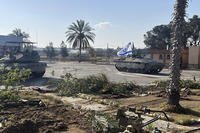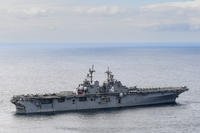
As a follow-up to my EMALS interview with Capt. Rorke, the cats and traps czar at NAVAIR, I spoke with Capt. Michael Schwartz, the Future Aircraft Carrier Program Manager at NAVSEA.
Capt. Schwartz provided some details behind Capt. Rorke's somewhat cryptic references regarding the future catapult system's "shipboard integration challenges." And DT is pleased to report all is well.
First, EMALS did indeed exceed its alloted real estate at one point, but that issue actually forced engineers into the realization that - because of excess capacity - they could get away with three energy storage devices per catapult instead of 4. Real estate concerns gone.
Schwartz also explained EMALS has the reliablity and survivability features that the legacy system does not: Any of the energy storage devices can serve any of the cats. "Right now [with the current steam catapult system] if a component breaks, that cat is down," Schwartz said. "With EMALS that won't be the case."
And the weight problem? Well, get a load of this: Each catapult exceeds its target weight by 100 tons. The solution? No action required. They're simply going to suck it up. Schwartz explained that the USS Gerald R. Ford is designed to weigh 100,000 tons, give or take 5,000 tons. So a mere 400 tons is noise.
And here is where old skool brownshoes start to feel the years raging by: Because there's no steam plant to warm up and components to elongate, etc., there will be no need to shoot "no loads" before flight ops commence. And the EMALS system doesn't have a water brake to stop the shuttle at the end of the stroke. The system simply uses reverse magnetic polarity to stop. So there won't be that skull-jarring smash at the end of each cat shot anymore. Peace in Wardroom One! The squadron bubbas will actually be able to hear each other's stories now.
Additionally, cat shots can be programmed to be extremely smooth while still giving aircraft the proper end speed off the bow (and waist). No more INS alignment-dumping shots like Cat 4 on Indy back in the day. Strap on some AIM-54s and a TARPS pod . . . now that was a shot, my friends. And this sort of programming around EMALS has built-in safeguards that will eliminate the need for aviators to roger a weight board as they taxi up to the cat. (So what are Super Hornet WSOs supposed to do while the pilots are spreading the wings?)
Throw in UCAS sharing the flight deck come 2020 and you have a recipe for paralyzing future shock. Alas, Capt. Schwartz allayed my fears somewhat: "We want to honor the time-tested mechanisms that have served to make carrier aviation safe," he said. "People will still be in the loop where required."
(Pictured: CVN 77 under contruction)
-- Ward








